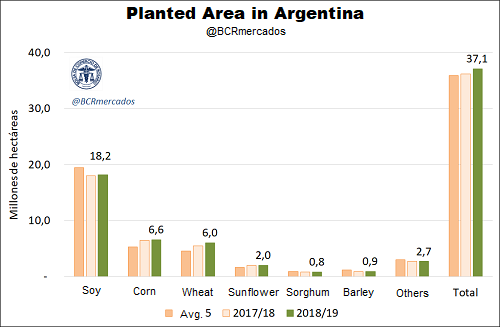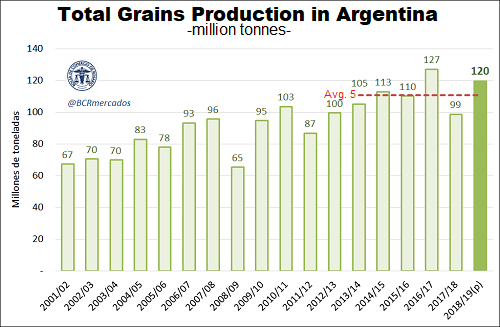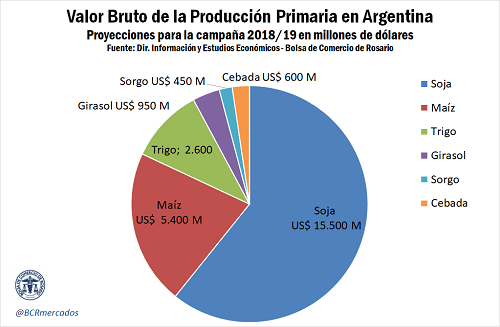Perspectives for Argentine agriculture in 2018/19
Rosario Board of Trade - Economic Research Department
In the current crop year, an increase in the planted area is foreseen, with an investment of US $ 10,100 million. Expectations are put in the next season, hoping to leave behind a 2017/18 that produced a very negative balance for Argentine primary production. The worst drought in 50 years was followed by a period of intense and widespread rains in full harvest season, which determined a production no greater than 100 million tons, when initially 130 Mt. Over the last days, the first plantings of 2018/19 started, anticipating an advance in the total area. In wheat, an implantation of 6 million hectares (Mha) is estimated, 10% above the last year. In barley, the prospects for planting amount to 900,000 hectares, also exceeding the coverage of the previous year. The sunflower, meanwhile, would cover about 2 million hectares. For corn and sorghum, a planted area of 6.6 and 0.8 Mha is projected, respectively, while soybeans would cover 18.2 Mha, recovering 1% in relation to last year. If these projections are met, the total area planted in Argentina in 2018/19 would reach a historical record of 37.2 million hectares, in line with the intentions of the previous year, although one million hectares above what could actually be implemented then.
Assuming that the yields remains its trend values for each crop, the plantings would obtain a total grain production of 120 million tons in the 2018/2019 season, well above the 99 million from the previous season and the second largest record of the story.
Gross value of primary production in US $ 25,500 million If we focus specifically on the six main crops (corn, soy, wheat, sunflower, barley and sorghum) and multiply the projected production by current harvest prices, the expected production could reach a gross value (VBP) of US $ 25,500 million. Of this, 61% would be provided by soybeans, with a contribution to the national VBP of US $ 15,500 million. Maize, meanwhile, would contribute 21% of the total (US $ 5,400 million), and wheat 10% (US $ 2,600 million). The remaining 8% would be distributed among sunflower (US $ 950 million), barley (US $ 600 million) and sorghum (US $ 450 million).
Potential exports for US $ 26,400 million It is estimated that these six crops could generate a foreign exchange income to Argentina in terms of exports that could be around US $ 26,400 million. The main contribution to the trade balance would come from the soybean complex, responsible for more than 40 million tons of exports between beans and by-products, for a total of US $ 18,400 million (70% of the total). Maize, for its part, would ship some 22.5 Mt for a total of US $ 4.1 billion, or 16% of the foreign exchange income of the primary sector, while the wheat complex would ship some 13 Mt for a total amount around to US $ 2,700 million (10% of the total). The sunflower complex would account for another 3% of the value of exports of grains and derivatives, while the remaining 2% will be provided by barley and sorghum. Producers would invest a little over US $ 10,000 million in the implementation of the main crops It is estimated that the projected implementation of soybeans, corn, wheat, sunflower, barley and sorghum for 2018/19 of 34.4 million hectares will require a total investment of the productive sector of more than US $ 10 billion, from which more than 90% correspond to soy, corn and wheat. Maize, particularly, is the crop that requires the largest expenditures per hectare planted with US $ 450 / ha, although the largest area to implement soybeans takes most of the investment in spite of its lower relative cost per hectare (US). $ 250 / ha). Thus, while cereal production will require a total planting expense of US $ 3,000 million, the oilseed will require US $ 4,550 million to be invested. Wheat and barley, on the other hand, have a very similar cost of planting per hectare at around US $ 290 and 300 / ha, respectively, demanding a total investment of US $ 1,740 and 270 million; while the implementation of sunflower will require funds for US $ 455 million and sorghum, with a more modest technological package, US $ 156 million.


